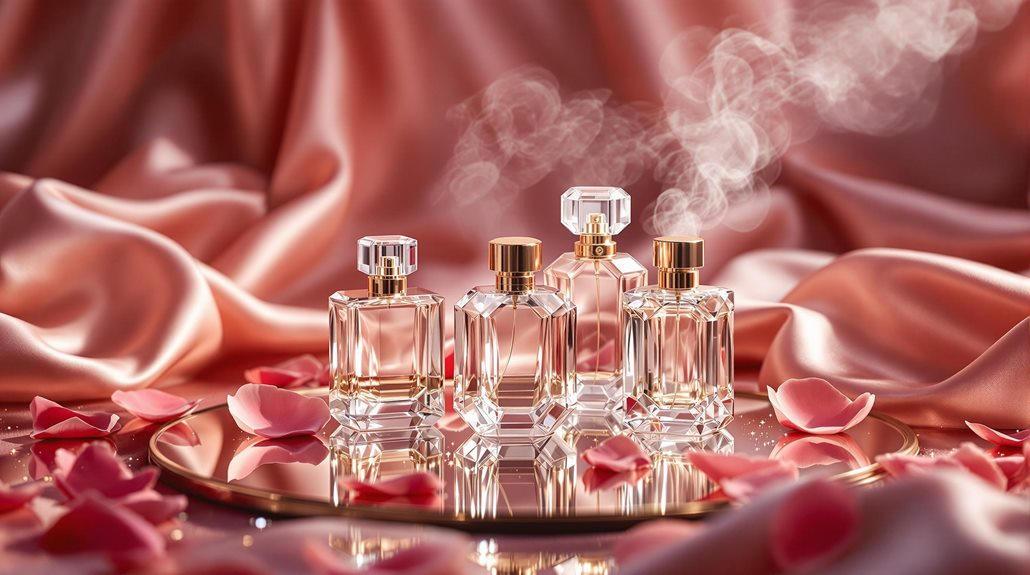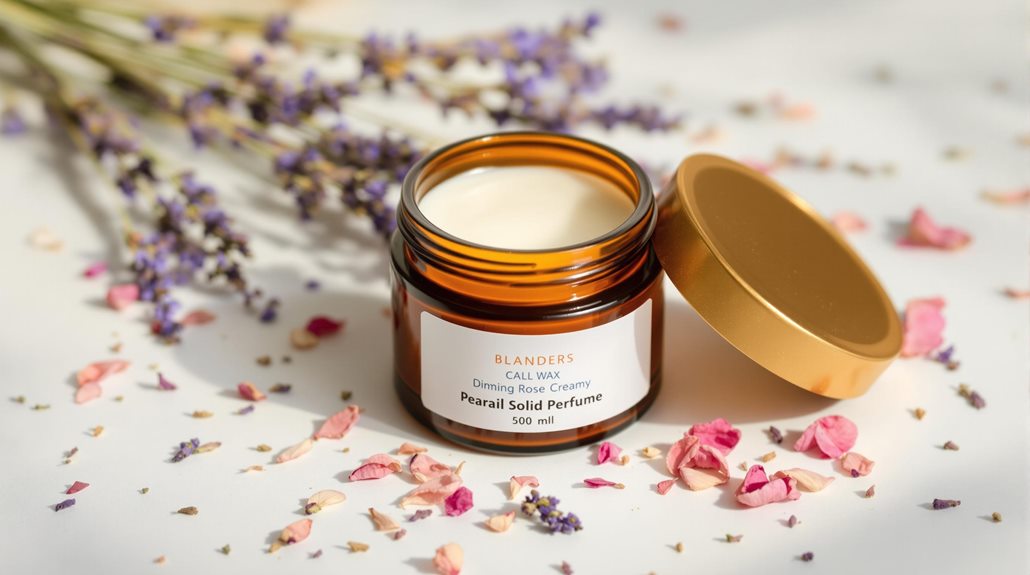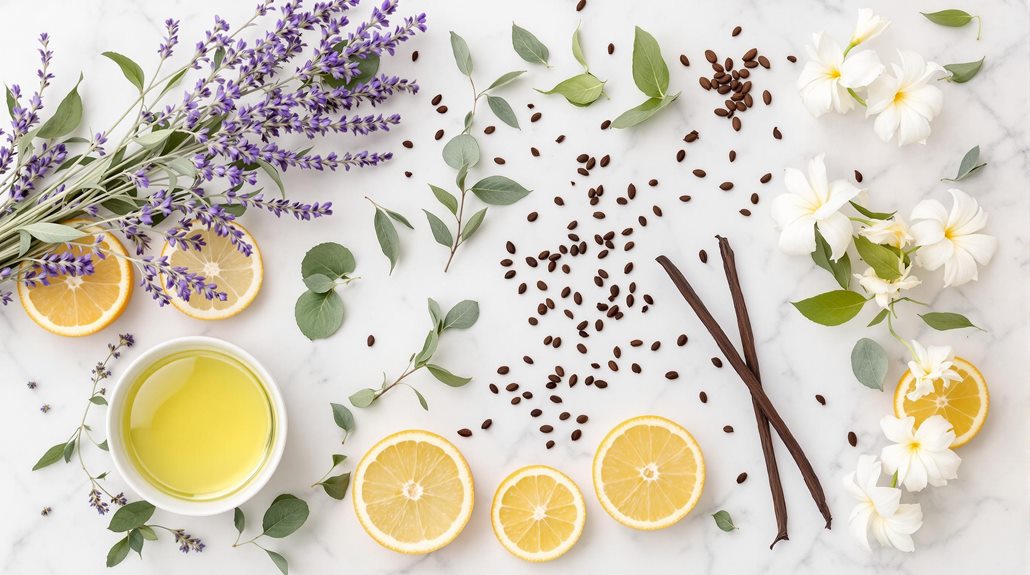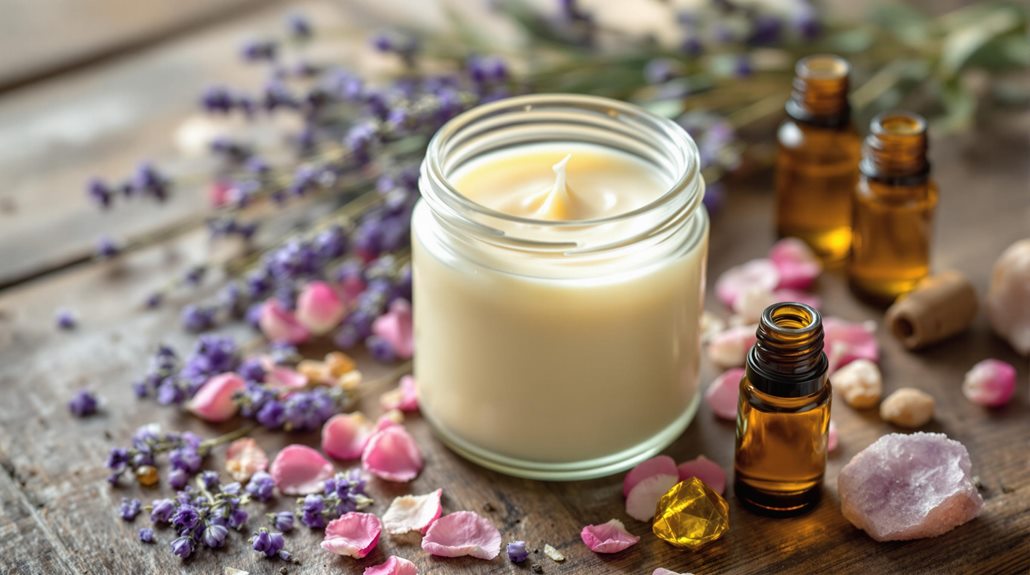The World's Most Expensive Perfume: What Makes It So Valuable?
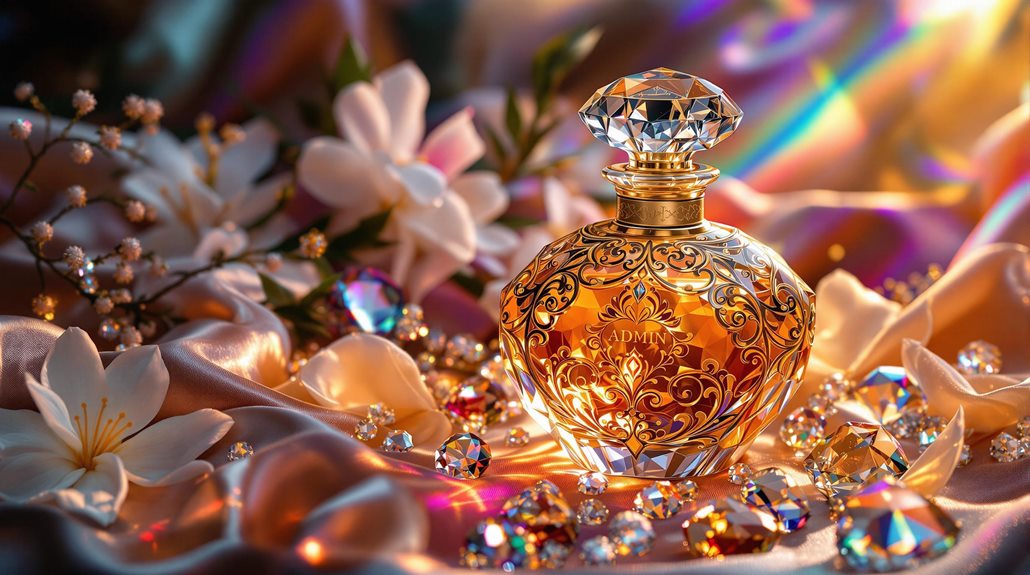
The world's most expensive perfumes earn their astronomical price tags through several key factors you'll find fascinating. Each bottle represents a virtuosic blend of the rarest ingredients like ambergris (worth $100,000 per pound) and oud (more valuable than gold). You'll discover these fragrances housed in hand-crafted crystal bottles adorned with precious gems, often requiring over 1,500 hours of artisanal work. Acclaimed perfumers, commanding million-dollar salaries, travel globally to source exclusive ingredients and create perfect scent harmonies. Restricted production runs and exclusive distribution channels guarantee these bottles remain coveted treasures. The deeper you explore this world of luxury perfumery, the more extraordinary its secrets become.
The Art of Rare Ingredients
The world of luxury perfumery revolves around nature's most elusive treasures. When you investigate the components of the world's most expensive fragrances, you'll uncover an extraordinary collection of rare ingredients that command staggering prices.
Consider ambergris, a precious substance found in sperm whales' digestive systems, which can cost up to $100,000 per pound and serves as a superior scent stabilizer. You'll find saffron, harvested from the delicate stigmas of Crocus sativus flowers, contributing its distinctive aroma at up to $5,000 per pound. The mysterious oud, a fragrant resin that forms in only 2% of agar trees, has become so valuable it's worth more than gold.
Natural musk, once highly sought after, has become so scarce that perfumers now primarily use synthetic alternatives. The creation process of Vanilla planifolia is equally fascinating, requiring painstaking hand pollination and years of maturation, with premium varieties fetching up to $600 per pound. These rare ingredients represent not just exotic scents, but also the intersection of nature's rarity and human craftsmanship, making them essential components in the world's most prestigious perfumes.
Precious Materials and Exquisite Packaging
When examining what makes luxury perfumes command astronomical prices, you'll uncover that exquisite packaging plays just as crucial a role as the fragrance itself. The world's most expensive perfumes showcase extraordinary craftsmanship through their crystal bottles, precious stones, and opulent materials. You'll find masterpieces like Shumukh by Nabeel, featuring a gold-painted metal pyramid design adorned with over 3,571 precious stones, pure silver, and 18-carat gold.
- Hand-cut crystal work by prestigious houses like Baccarat, creating flawless vessels that capture and reflect light beautifully
- Diamond-studded stoppers and caps plated with 24-carat gold, adding both luxury and functionality
- Intricate embellishments featuring rare precious stones, from diamond crown designs to pearl-encrusted bows
- Limited edition packaging by luxury brands like Bvlgari and Dior, where each exquisite bottle becomes a collector's item
When you invest in these ultra-luxury perfumes, you're not just buying a fragrance – you're acquiring a piece of wearable art where every detail, from the diamond-encrusted cap to the hand-crafted crystal base, represents the pinnacle of luxury craftsmanship.
Master Perfumers and Their Craft
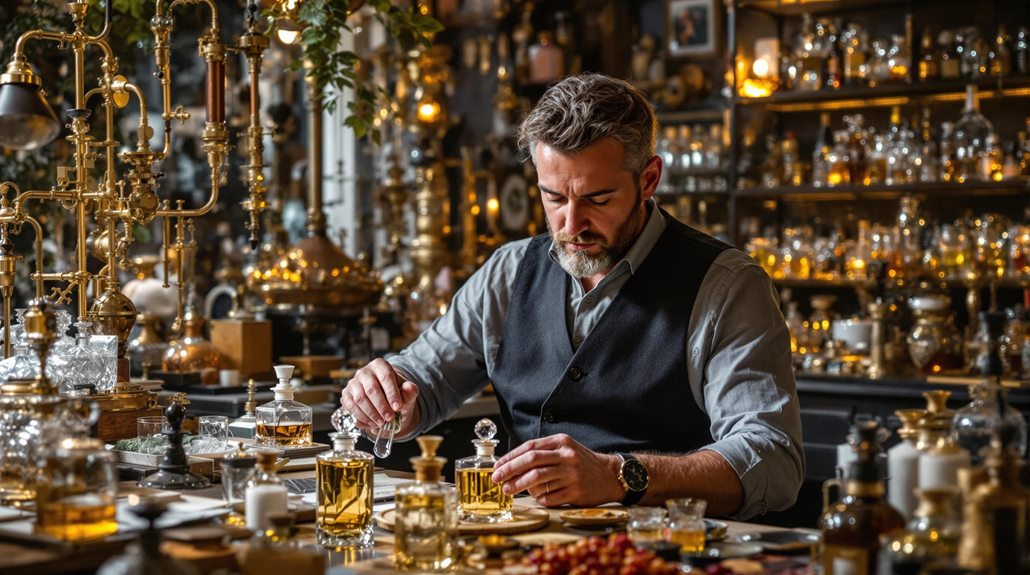
Behind every extraordinary luxury fragrance stands a skilled perfumer whose proficiency blends scientific precision with artistic vision. Experienced perfumers like Olivier Polge and Thierry Wasser have spent decades refining their craft, earning positions at prestigious houses like Chanel and Guerlain, where they command salaries exceeding $1 million annually.
You'll find these experts embarking on global journeys to source the world's most rare ingredients, from precious oud to delicate jasmine. Their creative intuition, combined with deep scientific knowledge, allows them to understand how essential oils and other components interact to create complex scent profiles that mesmerize the senses.
The art of fragrance blending is a painstaking process that showcases the true mastery of perfumery. When you experience a luxury perfume, you're witnessing the culmination of hundreds of hours of careful formulation and thousands of iterations. These masters scrupulously adjust each note until they achieve the perfect harmony of scents. Their expertise guarantees that every bottle contains not just a fragrance, but a masterpiece that reflects years of dedication to their craft and an unwavering commitment to excellence.
Limited Edition Production Secrets
Inside the secretive world of limited edition perfumes, expert craftsmen revamp rare materials into million-dollar masterpieces through precise processes that expand the horizons of luxury fragrance creation. You'll find that these highly exclusive pieces combine exceptional craftsmanship with precious stones to create bottles that are as priceless as the rare ingredients they contain.
The painstaking hours invested in these ultra-limited premier pieces yield stunning results, as evidenced by some of the world's most coveted fragrances:
- DKNY's "Golden Delicious" demands over 1,500 hours of diligent work to set 2,909 precious stones, resulting in its astronomical price of $1 million
- Clive Christian's "No. 1 Passant Guardant" features a crystal flacon adorned with 2,000+ diamonds and a distinguished gold collar
- Bvlgari's "Opera Prima" showcases an intricate combination of citrine, amethyst, and diamonds totaling nearly 280 carats
- Each bottle undergoes rigorous quality control, with skilled artisans personally overseeing every detail from stone setting to final assembly
You're not just buying a perfume; you're investing in an artisan's dedication to creating something truly extraordinary, where every detail reflects the pinnacle of luxury craftsmanship.
Celebrity and Historical Significance
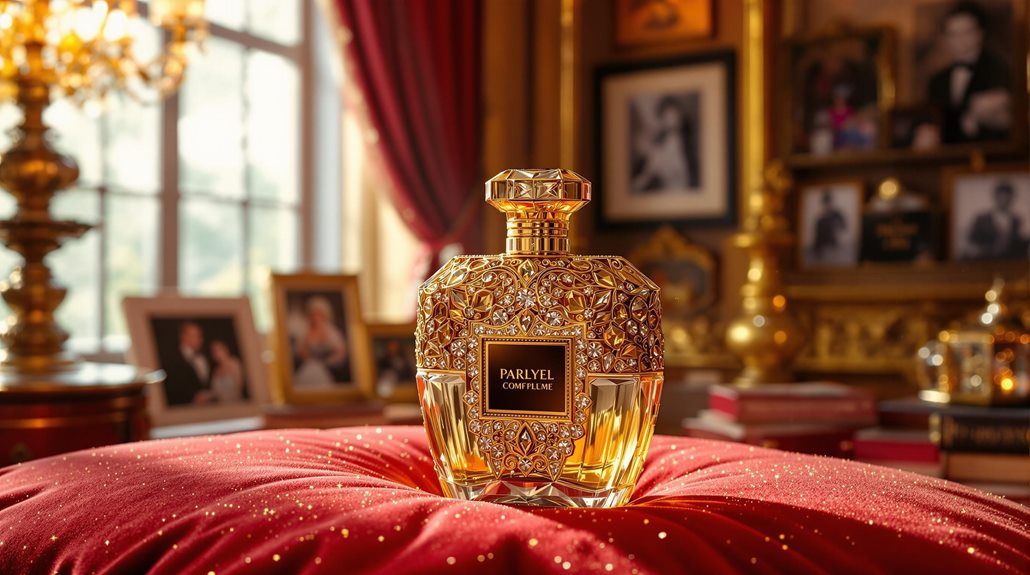
Through the decades, luxury perfumes have gained extraordinary value not just from their ingredients, but from their connection to iconic figures and historical moments. You'll find this perfectly illustrated in Marilyn Monroe's personal Chanel No. 5 bottle, which commanded $10,000 at auction, proving how celebrity association can transform a fragrance into a coveted collector's item.
Historical significance plays an equally indispensable role in a perfume's value. The 1929 Baccarat Edition of Chanel No. 5, now available only through resellers, represents a pinnacle of craftsmanship from perfume's golden age. Similarly, Pleine Lune sur le Nil from 1934 holds immense value due to its brief production run and historical importance in perfume-making.
Modern limited-edition releases are following this tradition of exclusivity. The Cry Baby Perfume Milk by Melanie Martinez demonstrates how cult followings can drive prices to over $2,000 in the resale market. Viktor & Rolf's Flowerbomb Haute Couture, with just 15 bottles produced, exemplifies how extreme rarity combined with luxury branding creates instant collectibles. You're not just buying a fragrance - you're investing in a piece of perfume history.
Investment Value Over Time
Luxury perfume's investment potential rivals that of fine art and rare wines, with certain bottles appreciating dramatically over time. You'll find that rare and limited-edition fragrances can multiply in value, as demonstrated by Marilyn Monroe's Chanel No. 5 bottle, which sold for 40 times its original retail price.
Consider these key factors that drive perfume investment value:
- Discontinued iconic fragrances become incredibly valuable, like Pleine Lune sur le Nil, which now commands up to $75,000 due to its scarcity
- Customized and bespoke creations, such as Morreale Paris Le Monde Sur Mesure, gain value through their unique production process and exclusive delivery methods
- Exquisite, jewel-encrusted bottles like Clive Christian's No. 1 Passant Guardant appreciate due to their extraordinary craftsmanship and collectability
- Commemorative editions, including Dior's Jadore L'or Prestige Edition, become coveted collector's items thanks to their limited availability and precious materials
When you're considering perfume as an investment, focus on bottles that combine multiple value-driving elements: rarity, historical significance, precious materials, and limited accessibility. These characteristics fortify the strongest potential for appreciation over time.
Exclusive Distribution Channels
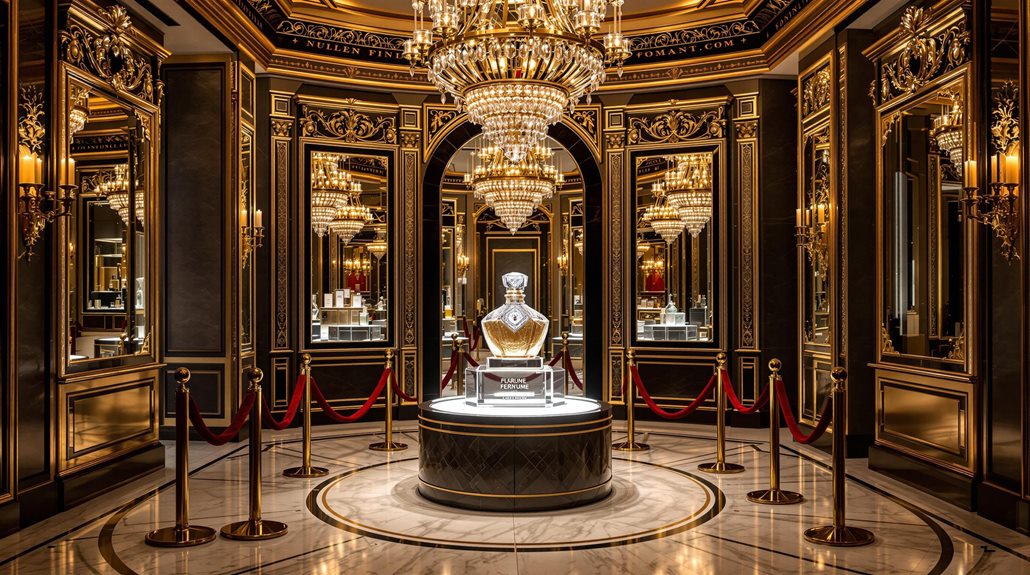
Behind the world's most expensive perfumes lies a carefully orchestrated network of exclusive distribution channels that you won't find in typical retail environments. If you're seeking the most precious blend of jasmine and rare ingredients, you'll need access to invitation-only boutiques like the Salon de Parfum boutique or elite perfume houses such as Parfums De Burmann.
These ultra-luxury perfumes, often housed in crystal and gold-adorned bottles, aren't available through traditional retail channels. You'll uncover that many brands deliberately limit their distribution to maintain an aura of exclusivity, with some fragrances produced in batches of just a few bottles per year. To acquire these rarities, you'll need to maneuver private buying channels, specialized auction houses, or work directly with the perfume houses themselves.
For the most discerning collectors, bespoke perfume experiences offer the ultimate in exclusivity. You can commission your own signature scent, though prices per bottle can reach astronomical figures. These personalized creations, along with limited-edition releases, are typically sold through highly controlled channels that cater to an elite clientele, ensuring their status as the world's most sought-after fragrances.
Luxury Brand Heritage
A brand's storied heritage plays an indispensable role in commanding astronomical prices for the world's most expensive perfumes. When you're buying a luxury fragrance from houses like Chanel, Dior, or Clive Christians, you're not just purchasing perfume bottles filled with exquisite scents - you're investing in centuries of craftsmanship and prestige.
The world's most treasured perfumes often come from brands with deep-rooted connections to high society and artistic excellence. You'll find that houses like Baccarat and Bulgari harness their longstanding reputation for luxury to create limited-edition fragrances that command premium prices. Similarly, adept perfumers at Jean Patou and Roja Parfums have cultivated devoted followings through their unshakable commitment to artisanal expertise.
- Established houses like Chanel and Dior carry generations of perfume-making proficiency
- Historical connections to royalty and high society enhance perceived value
- Time-honored production techniques ensure exceptional quality
- Limited distribution maintains exclusivity and mystique
These heritage factors combine to create an aura of prestige that justifies the extraordinary prices of the world's most coveted fragrances.
Conclusion
You've now glimpsed the extraordinary world of elite perfumery, where rare ingredients, expert craftsmanship, and limited availability create astronomical values. Whether you're enthralled by the precious materials, the artisan's skills, or the investment potential, these fragrances represent more than just scents - they're liquid masterpieces. While you might not splurge on the world's most expensive perfume, you can appreciate the artistry behind its exceptional price tag.

